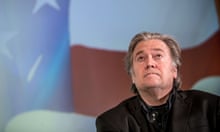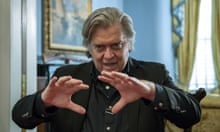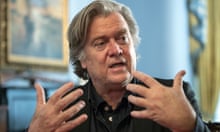Most recognise him as the dishevelled former Breitbart News boss who ran the triumphal last leg of Donald Trump’s election campaign and then became – until his sudden ejection, seven months in – the new president’s chief strategist.
Some may recall Steve Bannon was once at Goldman Sachs, and executive produced a few Hollywood movies. But not many know that he also made films of his own – and might justifiably be considered one of this young century’s more significant propaganda artists.
“I don’t want to give him too much credit, because the idea that he’s a successful propagandist is, of course, all part of his propaganda,” said Jonas Staal, a Dutch artist and propaganda researcher. “But it’s true that he has succeeded, like few others over the past 15 years, in turning an artistic representation of his ideas into political reality.”
This, said Staal, whose exhibition – Steve Bannon: a Propaganda Retrospective – opened in Rotterdam on Friday, is why, despite his fall from Trumpian grace, the alt-right’s dystopia purveyor is so important. “He’s developed this artistic horizon, but it’s not a ‘what if’, it’s a script.
“And what Bannon’s work shows is that the script for Trumpism was written long before Trump came along. Our reality has been co-authored by Steve Bannon. His core ideas have become the contemporary paradigms we are living with today.”
ProfileWho is Steve Bannon?
Show

Born in Norfolk, Virginia in 1953, Steve Bannon was the chief executive officer of Donald Trump’s election campaign in its final months in 2016. He later served as the president’s chief strategist for seven months during the early phase of his administration. He was fired in the summer of 2017, but Trump is recently said to have been talking about him positively.
The bluntly spoken, combative Bannon was the voice of a nationalistic, outsider conservatism, and he pushed Trump to follow through on some of his most contentious campaign promises, including his travel ban on several majority-Muslim countries.
He led the rightwing Breitbart News before being tapped to head Trump's campaign, where he pushed a scorched earth strategy.
After Trump fired him, Bannon launched a European operation called the Movement. Based in Brussels, it was set up to give far-right parties access to polling data, analytics, advice on social media campaigns and help selecting candidates. “Remember ‘Bannon’s theorem’,” he told the Guardian at the time. “You put a reasonable face on rightwing populism, you get elected.”
Bannon, who served in the navy and worked as an investment banker at Goldman Sachs before becoming a Hollywood producer, had been hosting a pro-Trump podcast called "War Room" that began during the president's impeachment proceedings and had continued during the pandemic.
He was arrested in August 2020 and charged with fraud over a fundraising campaign called We Build the Wall.
Through extended clips from Bannon’s nine documentaries, shown alongside books, artefacts and information panels for background and context, the exhibition sets out to show how Bannon’s artistic work first foreshadowed, then shaped, the core narratives of Trumpism, tracing a direct line from his early free-market activism through Breitbart to his role in the scandal-hit data-mining firm Cambridge Analytica.
Made between 2004 and 2016, the little-known films – only four had even a limited cinema release, the rest going straight to video – trace the development of Bannon’s core ideology. This appears to have been radicalised after the 9/11 attacks, from his near hero-worship of Ronald Reagan to his engagement with the Tea Party, support for Sarah Palin, disgust with the Occupy movement and more recent embrace of the far right.
They reveal an apocalyptic world view. Western society, Christianity and freedom are under attack, not just from evil foreigners but establishment insiders: corrupt government, big banks, a cosmopolitan elite. Illegal immigration, crony capitalism and progressive liberalism are threatening the country; only economic nationalism, hardcore conservatism and a crushing victory in the coming clash of civilisations will save it.
“There’s always, too, a search for leadership,” said Staal, “the need for leaders who can carry the message of white Christian, free-market nationalism. Bannon builds a narrative around these characters. Trump may be a rather imperfect version of the warrior he would ideally have liked, but the ideology is there, the battle between good and evil, the clash of civilisations. Bannon believes that like the communists and Nazis before them, Islamic terrorism and the global elite must be defeated.”
They are not of course “good” films in an aesthetic sense. With titles including Generation Zero (the “real” causes of the financial crisis), The Undefeated (Sarah Palin as epic defender of family values, the Christian faith and economic nationalism), In the Face of Evil (Reagan’s struggle against communism), Battle for America (the rise of the Tea Party) and 2016’s The Torchbearer (starring the bearded, ultra-conservative religious zealot Phil Robertson as the west’s last barricade against Islamist terror and secularism), they feature a surfeit of unsubtle metaphors, from the meteorological (hurricanes, snowstorms, avalanches) to the animal (circling sharks, grizzly bears, American eagles).
In a 2011 interview with Vanity Fair, Bannon described himself as an exponent of what he called “kinetic” cinema, aiming to overwhelm the audience with such an intense barrage of images and core messages that it was almost impossible to avoid them. But the films’ underlying narratives have undeniably been influential: despite Bannon’s abrupt eviction from the White House, the reality they construct is, broadly, the one that still animates the administration.
“These films were not made,” says Staal, “for the kind of audience that critiques them. Of course, it’s easier to examine the core narratives than to measure their impact. But Trump’s successful campaign and, beyond the US, Leave’s victory in the UK’s Brexit referendum, the rise of the ultranationalists in the Netherlands, France, Italy – there’s clearly a link between the success of these campaigns and the platforms that carried their core messages.”
A full-spectrum propagandist, Bannon’s efforts extend far beyond his films. He talks of a multi-platform “infrastructure”, ranging from film to far-right news channels, populist websites, social media troll armies and data-driven targeted advertising, telling the New York Times modestly in an interview last month: “All I am trying to be is the infrastructure, globally, for the global populist movement.”
His recent meetings with hard-right, nationalist, social-media driven parties in Italy, France – he spoke at the Front National’s annual conference, introduced by Marine Le Pen – and Germany are part of his effort to build that infrastructure.“What’s essential to realise about propaganda,” said Staal – who completed a PhD in propaganda art earlier this year – “is that it is not, actually, about sending a message. It’s about shaping our environment, engineering our reality. Propaganda is the performance of power; propaganda art – which is an important element of propaganda, because a reality has to be portrayed before it can be reality – is the performance of power as art.”
Nor is it inherently a product of totalitarian regimes. “When I began researching the subject,” he said, “I was struck first of all by the absence of the word in present-day debate. Historically, in the 20th century, people think first of Nazi film-makers and Stalinist socialist-realist paintings. Today, we associate propaganda with the last totalitarian regimes still standing – North Korea, for example.”
But propaganda is plainly not the prerogative of dictatorships, Staal said. In fact modern democratic propaganda was effectively pioneered, he argued, by Britain’s Wellington House operation in the first world war: “A crucial example of democratic propaganda which sought to effectively engineer reality without people seeing or recognising it as such.”
And Bannon, said Staal, is “a very important current example of a contemporary propagandist operating within a democratic society. It’s no accident that Andrew Breitbart [Breitbart’s founder] has called him ‘the Leni Riefenstahl of the alt-right’.”
The Rotterdam exhibition aims to display the “visual and ideological architecture of the alt-right” to a broader audience, to “open up spaces and opportunities for critique – and resistance”. Countering effective propaganda art, Staal said, is not easy.
“If you accept the idea that no reality is devoid of power, then propaganda is everywhere.Every society needs a narrative – where we come from, who we are, where we are going. The problem is that the alt-right gives us a very clear story, that ‘we’ are a predominantly white, predominantly Christian society that is under attack and needs defending. It’s the root of the present-day culture wars: they have effectively defined ‘us’ and ‘them’.”
To counter that, Staal argues, “We need to define an ‘us’ that is a much more pluralistic reality. This has to be the task of progressive art and politics today: to tell a more inclusive story of who we are, and who we can still become. Because facts alone – as the Brexit vote showed very clearly – will convince no one.” We need a fact-based, alternative narrative.”
Art, and particularly political art, has a major role to play, he argues. “The propaganda against art has been very effective. This idea that ‘art should be depoliticised’, that ‘only by maintaining a fictional neutrality can art call itself art’, is actually a huge obstacle to understanding art’s place and effect in the world – and the potential contribution that art could make in developing counter-narratives to the alt-right.”
That, he believes, is the real challenge: to contribute a “defiant imagination of a different world” – create the radical opposite of the alt-right’s paranoid vision. “Because from the propaganda perspective, there is a real cultural dimension to the alt-right. They are producing art: you could call their Pepe the Frog meme a contemporary version of a court portrait ... That’s what we have to recognise, deconstruct, and counter.”
Steve Bannon: a Propaganda Retro-spective is at Het Nieuwe Instituut, Rotterdam until 23 September










Comments (…)
Sign in or create your Guardian account to join the discussion